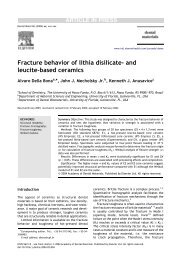Microleakage of various cementing agents for full cast crowns
Microleakage of various cementing agents for full cast crowns
Microleakage of various cementing agents for full cast crowns
You also want an ePaper? Increase the reach of your titles
YUMPU automatically turns print PDFs into web optimized ePapers that Google loves.
448<br />
adhesives as recommended by the manufacturers<br />
(Table 1). Dentin adhesives were not used <strong>for</strong> the<br />
zinc-phosphate cement, the conventional glass–<br />
ionomer cement, and the self-adhesive resin<br />
cement. Bonding was per<strong>for</strong>med by loading the<br />
<strong>cementing</strong> agent into the interior surface <strong>of</strong> the<br />
restoration and applying finger pressure <strong>for</strong> 10 s.<br />
Then the frameworks were axially loaded at a<br />
constant weight <strong>of</strong> 58.8 N <strong>for</strong> 7 min [15]. Excess<br />
cement was removed with a scaler; marginal fit was<br />
checked both by visual inspection and with a probe.<br />
All tooth-restoration specimens were stored in<br />
distilled water at 37 8C <strong>for</strong> 4 weeks, then they were<br />
subjected to 5000 thermocycles ranging from 5 to<br />
55 8C (immersion time, 20 s; transfer time, 10 s).<br />
Subsequently, the root surfaces <strong>of</strong> the restored<br />
teeth were covered with two layers <strong>of</strong> nail varnish<br />
(ending 2 mm below the crown margin) and subjected<br />
to silver nitrate penetration [16]. Then<br />
they were placed into an unimolar silver nitrate<br />
solution (Crystal, Fisher Scientific, Fairfield, NJ,<br />
USA) <strong>for</strong> 6 h, followed by thorough rinsing, storage<br />
in a photochemical developer (Solutek Corporation,<br />
Boston, MA, USA) <strong>for</strong> 12 h, and exposure to a 150-W<br />
floodlamp <strong>for</strong> 6 h.<br />
Next, the tooth-restoration specimens were<br />
embedded in a transparent resin matrix (Buehler<br />
Epoxide; Buehler, Lake Bluff, IL, USA), which was<br />
allowed to harden at room temperature <strong>for</strong> 24 h.<br />
Each resin block was cut twice in the buccolingual<br />
and the mesiodistal direction along the previously<br />
applied reference marks using a slow-speed diamond<br />
saw (Isomet; Buehler Ltd, Evanston, IL, USA) with<br />
water-cooling. In this way, each specimen featured<br />
eight surfaces (four in enamel and four in dentin) <strong>for</strong><br />
analysis <strong>of</strong> microleakage and marginal gap. The cut<br />
surfaces were once again placed under a 150-W<br />
floodlamp <strong>for</strong> 5 min, such that all portions <strong>of</strong> the<br />
silver nitrate penetration acquired a black color.<br />
Evaluation <strong>of</strong> microleakage and marginal gap<br />
using a high-resolution digital microscope<br />
camera<br />
The microleakage in the area <strong>of</strong> the tooth–cement<br />
interface was defined as linear penetration <strong>of</strong> silver<br />
nitrate starting from the restorative crown margins<br />
[17] and was determined with a stereomicroscope<br />
(475052-9901; Zeiss, Oberkochen, Germany) and<br />
AxioCam HR digital microscope camera (Zeiss,<br />
Oberkochen, Germany; s<strong>of</strong>tware module: Axio<br />
Vision 3.1). The images were taken at a resolution<br />
<strong>of</strong> 1300!1030 pixels. A micrometer scale (474026;<br />
Zeiss, Oberkochen, Germany) was placed diagonally<br />
across the image <strong>for</strong> calibration. The maximum<br />
potential calibration-related error due to the width<br />
<strong>of</strong> mapped lines was G0.709 or G0.475% depending<br />
on the magnification factor relative to the absolute<br />
measured values. Depending on the magnification,<br />
2.42 or 3.64 mm/pixel were obtained. Metric assessment<br />
<strong>of</strong> distances was per<strong>for</strong>med using micrometers<br />
(mm) as units. A randomly selected image including<br />
10 measurements was analyzed to determine the<br />
potential mapping error due to the definition <strong>of</strong><br />
microleakage length. Given a measured length <strong>of</strong><br />
1 mm, a maximum mapping error <strong>of</strong> G0.01 mm was<br />
obtained irrespective <strong>of</strong> the magnification factor.<br />
Marginal gaps were measured as defined by<br />
Holmes et al. [18] using the stereomicroscope<br />
(4730129901; Zeiss, Oberkochen, Germany) and<br />
digital microscope camera. The selected magnification<br />
was based on 1.21 mm equaling one pixel.<br />
Based on the absolute values measured, the<br />
maximum calibration-related error was G0.154%.<br />
A randomly selected image including 10 measurements<br />
was analyzed to determine the potential<br />
mapping error due to the definition <strong>of</strong> marginal gap<br />
length. Given a length <strong>of</strong> 40 mm, a maximum<br />
mapping error <strong>of</strong> G0.18 mm was obtained.<br />
Statistical analysis<br />
Descriptive representation <strong>of</strong> continuous variables<br />
was based on mean values, SD, and minimum–<br />
maximum values. In addition, a number <strong>of</strong> tests<br />
(skewness test, kurtosis test, and omnibus test)<br />
were used to analyze whether the frequency<br />
distribution <strong>of</strong> the random sample differed significantly<br />
from the normal distribution. Since, the bulk<br />
<strong>of</strong> data was not characterized by a normal<br />
distribution, a non-parametric Kruskal–Wallis test<br />
was used to analyze differences in the <strong>various</strong><br />
groups <strong>of</strong> <strong>cementing</strong> <strong>agents</strong>, comparing the<br />
obtained test parameters (Bonferroni-corrected p<br />
values). A non-parametric Wilcoxon’s test was used<br />
to evaluate the differences between enamel and<br />
dentinal substrates. The selected level <strong>of</strong> statistical<br />
significance was p!0.05. Spearman’s correlation<br />
coefficient (R) was used to assess the correlation<br />
between two continuous variables.<br />
Results<br />
A. Piwowarczyk et al.<br />
<strong>Microleakage</strong> with preparation margins<br />
in enamel<br />
Fig. 1 illustrates the mean values and SD <strong>for</strong> the<br />
microleakage findings obtained with the <strong>various</strong><br />
<strong>cementing</strong> <strong>agents</strong>. The smallest degree <strong>of</strong>
















